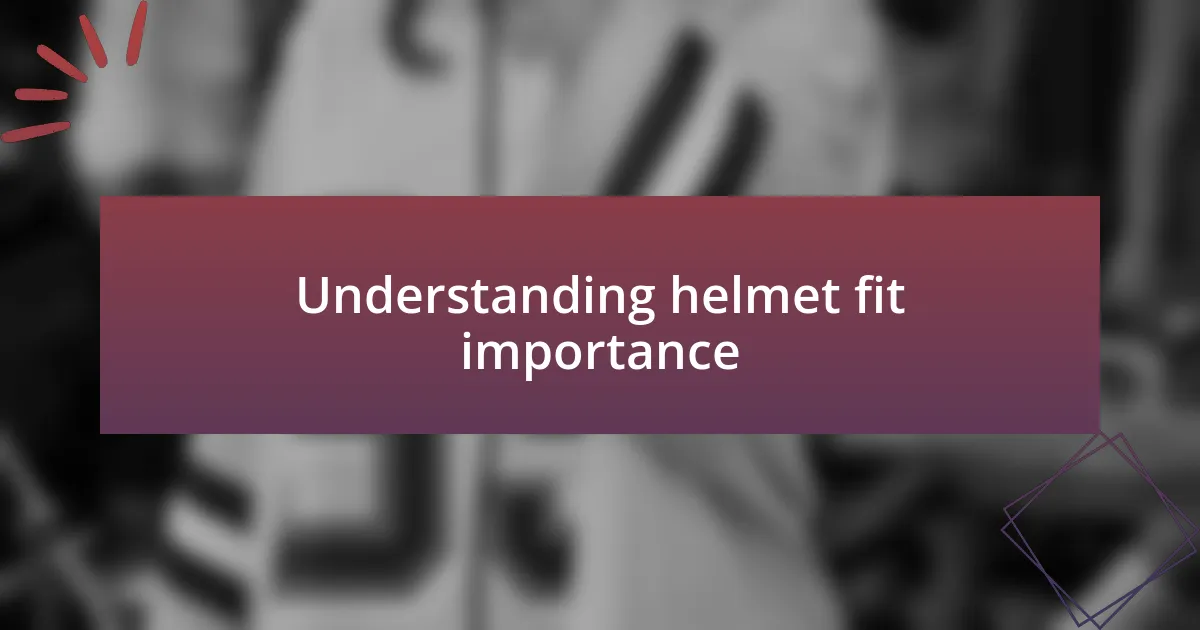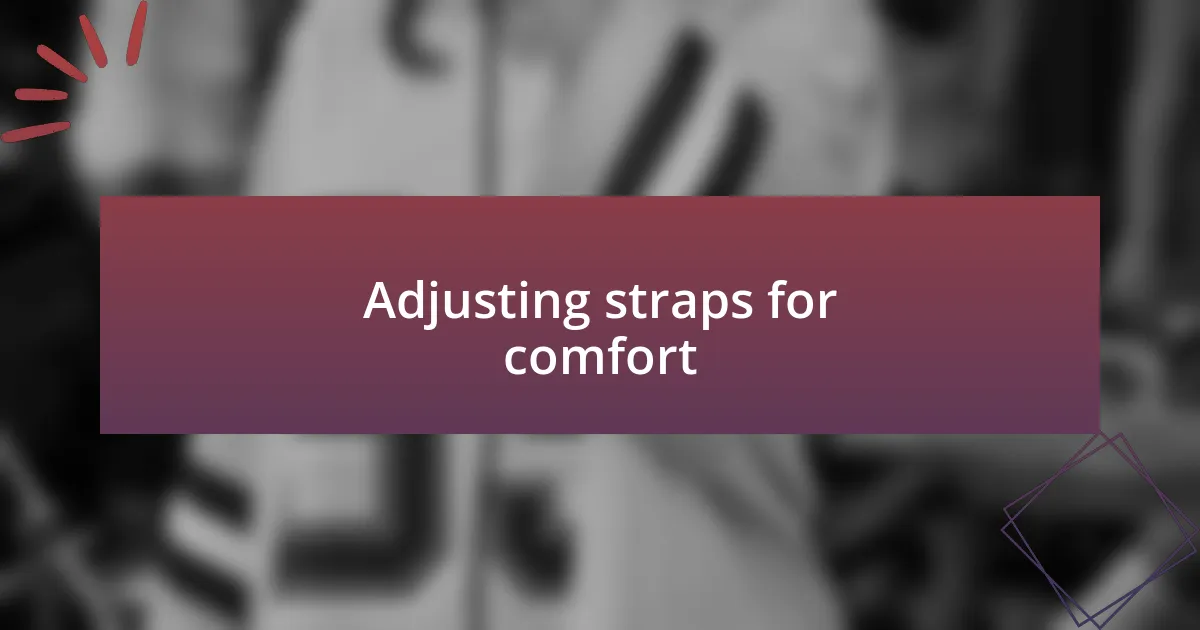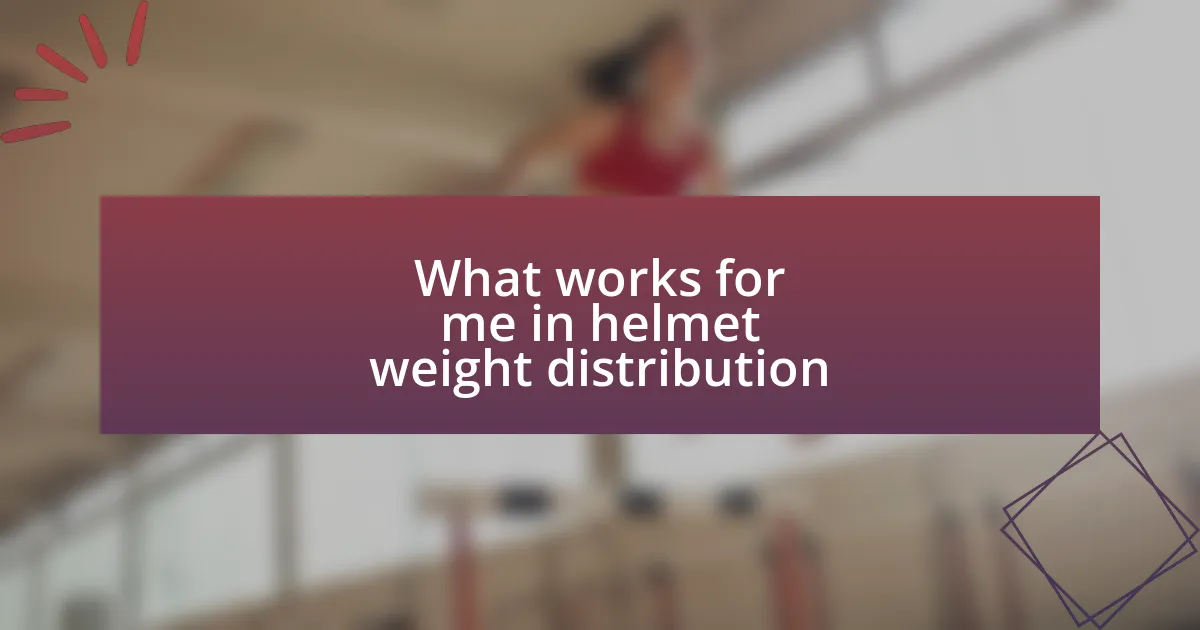Key takeaways:
- A snug helmet fit is crucial for safety, as loose helmets can lead to serious injuries.
- Different brands have varying sizing; always try on helmets and check adjustments for a proper fit.
- Adjusting straps correctly, particularly ensuring they form a ‘Y’ shape beneath the ears, enhances comfort and stability.
- Common fitting mistakes include neglecting side strap adjustments and not allowing time for pressure points to reveal themselves.

Understanding helmet fit importance
A snug helmet fit is crucial for safety. I remember the first time I put on a helmet that felt loose; it was unsettling. It made me wonder, what if it slid off during a ride? That thought alone made me realize the importance of a proper fit.
When helmets are too loose, they can’t effectively protect your head in case of an accident. I reflect on a friend’s experience; she had a helmet that didn’t fit right. In a minor spill, it shifted, leading to a bump that could have been avoided. Hearing that made me ask myself how something as simple as fit could have such significant implications.
Finding the right fit can feel like a puzzle. I recall trying on various sizes until I found one that felt like it was custom-made for me. It was a mix of comfort and security, and I understood that a well-fitted helmet does more than just sit on your head; it builds confidence. Isn’t it comforting to know that taking a few extra moments to ensure a proper fit can make all the difference in your safety experience?

Choosing the right helmet size
Choosing the right helmet size can feel daunting, but it’s essential for ensuring both comfort and safety. I still vividly recall my first shopping experience for a helmet. I thought I could just pick a size and go, but as I tried on different brands, I quickly learned that sizing can vary considerably. What fit perfectly in one brand felt like a pinhead in another. This realization drove home the importance of actually trying helmets on before making a decision, rather than just relying on the size label.
Here are some tips I learned along the way when selecting the right helmet size:
- Measure your head circumference with a soft tape measure, just above your eyebrows.
- Use the sizing chart provided by the helmet manufacturer, as sizes differ by brand.
- Try the helmet on and ensure it sits level on your head, not tilted forward or backward.
- Make sure there’s minimal movement when you shake your head—if it moves too much, it’s likely too big.
- Check that the padding feels snug but comfortable, providing a secure feeling without causing pressure points.
Finding the right fit can seem iterative, requiring multiple tries, but it is entirely worth it when you feel that perfect sense of security.

Adjusting straps for comfort
Adjusting the straps of your helmet can greatly enhance comfort and stability. I remember the first time I donned my helmet; the initial adjustment left me feeling like I was in a vice grip. I quickly learned that finding the right tension is crucial. The straps should be snug enough to keep the helmet secure, but not so tight that they create discomfort or headaches. It’s all about that sweet spot, where the helmet feels like an extension of my head rather than an intrusive accessory.
One particular trick I found helpful is the “Y” adjustment. Ensuring that the side straps form a ‘Y’ shape just below my ears made a noticeable difference in fit. It was incredible to feel the weight of the helmet evenly distributed, rather than pulling down awkwardly on one side. This was one of those “aha” moments that really changed the way I experienced wearing a helmet.
If you’re finding the straps too long, don’t hesitate to use the adjustable sliders. I often had to trim excess length on the straps during my early rides. Not only did this eliminate extra flapping, but it also made the overall feel so much cleaner. Remember, the goal is a snug, comfortable fit, which allows you to focus on the ride rather than adjusting your gear.
| Strap Adjustment Technique | Personal Experience |
|---|---|
| Y-Shape Adjustment | Forming the “Y” shape under my ears enhanced comfort and security. |
| Length Trimming | Trimming excess strap length reduced flapping and improved my helmet’s fit. |

Testing for secure fit
Testing for a secure fit is an essential step in ensuring your helmet will protect you when it counts. Once I thought I had the right adjustments, I performed a few simple tests that really helped me confirm the fit. I gently shook my head up and down, then side to side, and was surprised by how much movement I initially felt. When the helmet started shifting, I knew I had to tighten those straps further until it stayed firmly in place.
One of my go-to tests involved a careful pressure check. I pressed down on the front of the helmet while tipping my head forward; if the helmet shifted significantly, I knew it wasn’t snug enough. I still remember the sense of relief I felt when I finally got it right—after a few tries, the helmet felt secure without putting any unnecessary pressure on my forehead.
Last but not least, I paid close attention to the overall feel during a quick test ride. The first time I rode with the newly adjusted helmet, the comfort and stability felt remarkably different. Have you ever had that moment when everything just clicks? That’s what I experienced—no sliding or shifting, just a supportive fit that let me focus entirely on the road ahead.

Common fitting mistakes to avoid
When it comes to achieving a snug fit, one of the most common mistakes I see people make is neglecting the adjustment of the side straps. Many assume that the chin strap is sufficient for security, but if those side straps are too loose, the helmet can slide around, leading to potential injury. I remember a time when I got so caught up in how the chin strap felt that I overlooked those crucial side adjustments; it wasn’t until a friend pointed it out that I understood the importance of a comprehensive fit.
Another pitfall is forgetting to account for the shape of your head. Not all helmets are created equal; they come in various shapes, catering to different head contours. I learned this the hard way by purchasing a helmet that seemed perfect at first but actually didn’t match my head’s unique shape. It required a few frustrating adjustments and even swapping for a different model before I found one that hugged my head snugly—definitely a lesson learned!
Lastly, many people make the mistake of fitting their helmet based on just a few moments of wear rather than allowing time for any pressure points to reveal themselves. I’ve ridden with helmets that felt fine right after adjustment but later caused discomfort on longer rides. It’s essential to spend some time in the helmet, doing light activities, to ensure it isn’t just a good fit at first glance. Have you experienced that uneasy wear after a while? Trust me; spending that extra time to confirm the fit can save you from a ride turned sour.

Ensuring proper retention system
Ensuring the retention system works properly is vital for any helmet fit. I remember my early days of cycling where I underestimated the role of the buckles and straps. I thought as long as I secured the chin strap tight, everything was fine. However, it wasn’t until I hit a bump and felt the helmet shift that I realized the side retention system needed adjustment too.
Adjusting those side straps is not just a step; it’s a game changer. I encourage you to regularly check if the straps are lying flat against your head. This simple tweak can keep your helmet snug and secure, even during vigorous activities. Have you ever felt that rush of panic when your helmet shifted unexpectedly? I certainly have, and it’s a feeling I never want to experience again.
In my journey of ensuring my helmet fit just right, I discovered the importance of the padding and the adjustments that accompany it. After swapping out the default pads for thicker ones, I was amazed at how much stability it provided. It took some trial and error, but those adjustments transformed my comfort entirely. Isn’t it fascinating how such small changes can lead to a drastically improved experience? Every ride now feels safer and more enjoyable, all because I prioritized a proper retention system.



